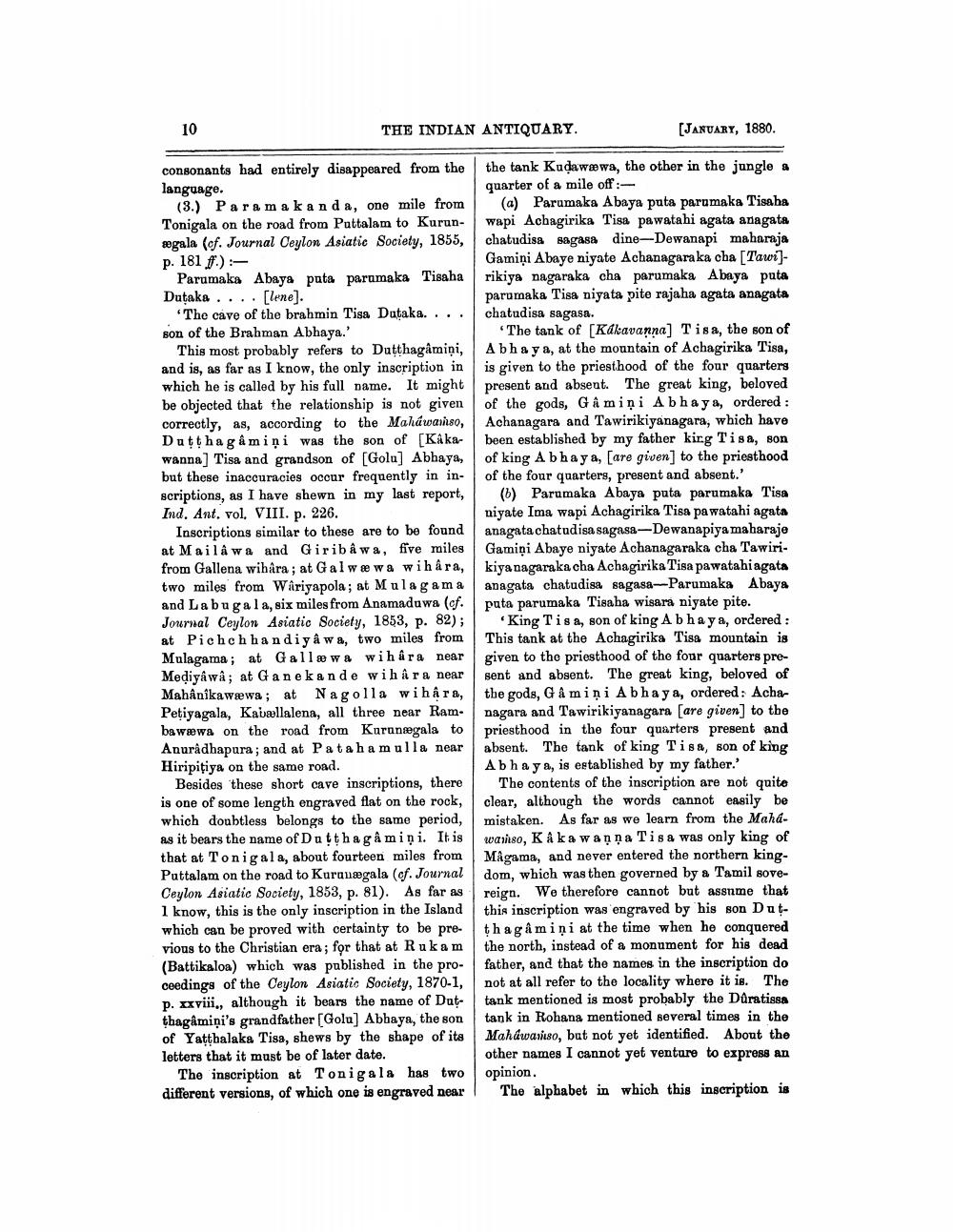________________
10
THE INDIAN ANTIQUARY.
(JANUARY, 1880.
consonants had entirely disappeared from the language.
(3.) Parama kanda, one mile from Tonigala on the road from Pattalam to Kurun- mgala (of. Journal Ceylon Asiatic Society, 1855, p. 181 f.):
Parumaka Abaya puta paramaka Tisaha Dutaka .... (lene].
The cave of the brahmin Tisa Dataka. ... son of the Brahman Abhaya.'
This most probably refers to Dutthagamiņi, and is, as far as I know, the only inscription in which he is called by his full name. It might be objected that the relationship is not given correctly, as, according to the Maháwariso, Dutthagamiņi was the son of [Kakawanna) Tisa and grandson of [Golu] Abhaya, but these inaccuracies occur frequently in inscriptions, as I have shewn in my last report, Ind. Ant. vol. VIII. p. 226.
Inscriptions similar to these are to be found at Mailâ wa and Giribâwa, five miles from Gallena wihara ; at Galwe wa wihara, two miles from Wariyapola; at Mula gama and Labuga la, six miles from Anamaduwa (cf. Journal Ceylon Asiatic Society, 1853, p. 82); at Pichchhandiya wa, two miles from Mulagama; at Gallæwa wihara near Mediyâwâ; at Ganekande wihara near Mahậnikawawa; at Nagolla wihara, Petiyagala, Kavallalena, all three near Rambawawa on the road from Kurunegala to Anuradhapura ; and at Patah a mulla near Hiripitiya on the same road.
Besides these short cave inscriptions, there is one of some length engraved flat on the rock, which doubtless belongs to the same period, as it bears the name of Dutthagamiņi. It is that at Tonigala, about fourteen miles from Puttalam on the road to Kurguægala (of. Journal Ceylon Asiatic Society, 1853, p. 81). As far as 1 know, this is the only inscription in the Island which can be proved with certainty to be previous to the Christian era; for that at Rukam (Battikaloa) which was published in the proceedings of the Ceylon Asiatic Society, 1870-1, p. xxviii., although it bears the name of Dutthagamiņi's grandfather (Golu] Abbaya, the son of Yatthalaka Tisa, shews by the shape of its letters that it must be of later date.
The inscription at Tonigala has two different versions, of which one is engraved near
the tank Kudawæwa, the other in the jungle a quarter of a mile off :
(a) Parumaka Abaya puta parumaka Tisaha wapi Achagirika Tisa pawatahi agata anagata chatudisa sagasa dine-Dewanapi maharaja Gamiņi Abaye niyate Achanagara ka cha [Tawirikiya nagaraka cha parumaka Abaya puta parumaka Tisa niyata pite rajaha agata anagata chatudisa sagasa.
The tank of [Kákavanna) Tisa, the son of Abhaya, at the mountain of Achagirika Tisa, is given to the priesthood of the four quarters present and absent. The great king, beloved of the gods, Gå mini Abhaya, ordered : Achanagara and Tawirikiyanagara, which have been established by my father kirg Tisa, son of king A bhaya, [are given] to the priesthood of the four quarters, present and absent.'
(6) Parumaka Abaya puta parumaka Tisa niyate Ima wapi Achagirika Tisa pa watahi agata anagata chatudisa sagasa-Dewanapiya maharaje Gamiņi Abaye niyate Achanagaraka cha Tawirikiya nagaraka cha Achagirika Tisa pawatahi agata anagata chatudisa sagasa-Parumaka Abaya puta parumaka Tisaha wisara niyate pite.
King Tisa, son of king Abhaya, ordered : This tank at the Achagirika Tisa mountain is given to the priesthood of the four quarters present and absent. The great king, beloved of the gods, G âmiņi Abhaya, ordered: Acha nagara and Tawirikiyanagara (are given] to the priesthood in the four quarters present and absent. The tank of king Tisa, son of king Abhaya, is established by my father.'
The contents of the inscription are not quite clear, although the words cannot easily be mistaken. As far as we learn from the Mahawariso, K Aka wanna Tisa was only king of MAgama, and never entered the northern kingdom, which was then governed by a Tamil sovereign. We therefore cannot but assnme that this inscription was engraved by his son Dutthagamiņi at the time when he conquered the north, instead of a monument for his dead father, and that the names in the inscription do not at all refer to the locality where it is. The tank mentioned is most probably the Daratissa tank in Rohana mentioned several times in the Mahawanso, bat not yet identified. About the other names I cannot yet venture to express an opinion.
The alphabet in which this inscription is




